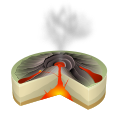2018 lower Puna eruption
The 2018 lower Puna eruption was a volcanic event on the island of Hawaiʻi, on Kīlauea volcano's East Rift Zone that began on May 3, 2018.
On the night of June 4–5, the northeastern flow of lava speedily moved forward and destroyed the subdivision of Vacationland Hawaii.
Puʻu ʻŌʻō had become a prominent volcanic cone 12 mi (19 km) east of the summit caldera of Kīlauea, since the 1983 eruption's beginning.
In the 1980s and 1990s, Puʻu ʻŌʻō produced lava flows that destroyed the nearby Royal Gardens subdivision and the settlement of Kapaʻahu.
In 1990, lava flows from the Kūpaʻianahā vent of Kīlauea, downrift from Puʻu ʻŌʻō, destroyed and partly buried most of the nearby towns of Kalapana and Kaimū.
[17][18] On April 30, 2018, the crater floor of the cone of Puʻu ʻŌʻō collapsed and the summit lava lake level in Halemaʻumaʻu dropped significantly.
In the first two days of May, hundreds of small earthquakes were detected on Kīlauea's East rift zone, leading officials to issue evacuation warnings for some residents of the Puna District.
[20][21] In connection with the eruption and its possible effects on the Hilina Slump, the Hawaiian Volcano Observatory published information concluding that the chance of a catastrophic collapse would be incredibly remote.
[45] Fissure 17 was unusual in that it erupted Kīlauea's first documented andesitic lava, a composition that is higher in silica and more viscous than the basalt that Kīlaeua normally produces.
At least two of these flows crossed through parts of Malama Kī Forest Reserve, blocked Highway 137, and flowed into the Pacific Ocean at Malama flats near MacKenzie State Recreation Area on May 19, producing clouds of irritating "laze" (lava haze), made up of steam, hydrochloric acid, and volcanic glass particles produced by littoral explosions.
[52] From May 23, eruptions at the eastern fissures began to weaken considerably, as lava activity moved back up the rift zone; older fissures reopened to release fluid pāhoehoe, which rapidly replaced the output of ʻaʻā, and led to massive pooling of lava over lower Leilani Estates.
The northeastern lava flow also cut power to Kapoho and nearby developments including Vacationland Hawaiʻi, and surviving sections of Leilani Estates and Lanipuna Gardens.
[62] By the morning of June 3, the lava flow from ʻAhuʻailāʻau had reached Kapoho and Vacationland Hawaiʻi, where it then destroyed hundreds of houses as it buried most of the town within a day.
By June 5, the lava had completely filled the bay, and preliminary reports from Hawaiʻi County officials indicated that hundreds of homes had been destroyed.
[64] In addition to the draining of Puʻu ʻŌʻō, the protracted release of lava along the Lower East Rift Zone has also led to significant drainage of lava away from Halemaʻumaʻu at Kīlauea, resulting in large scale inward slumping and collapse around the crater and regular earthquakes since May 17, similar in pattern to the crater's slumping during the 1924 event.
[65] Explosions or mild earthquakes of similar magnitude became an almost daily cyclical occurrence at the summit, and have also been reported to influence the intensity of lava surges at ʻAhuʻailāʻau.
[81] On August 15, 2018, the lower east rift zone eruption was reported to have subsided, with no new lava entering the channel from ʻAhuʻailāʻau in over a week.
While scientists cautioned that the eruption could resume at any time, in that week there was no further underground volcanic inflation registering on instruments, and no further summit collapse events, with only a small amount of lava active inside ʻAhuʻailāʻau.
[16] The Hawaii National Guard stated on May 11, 2018, that they were ready to evacuate up to 2,000 people at a moment's notice, through the use of land convoys and Blackhawk and Chinook helicopters.
[83] As the area of destruction grew significantly as a result of ʻAhuʻailāʻau's resurgence in late-May 2018, access to surviving sections of Leilani Estate within immediate proximity to the margins of the lava field began to be heavily restricted starting May 31.
[84] A proposed ban on future home construction in areas subject to high-risk of volcanic activity was also reported on July 1, 2018, to be in discussion by Hawaii politicians.
[86] In early June, a Winter Weather Advisory alert was issued for the higher areas of the island due to freezing rain and ice falling.
The quantity of lava reaching the ocean created large plumes of steam which rose high enough in the atmosphere to eventually condense and freeze before falling on the summit of Mauna Kea, 45 miles (72 km) from the eruption.
[1] Hawaii County's Voluntary Housing Program provides buyouts based on land values before the disaster to home and property owners.
